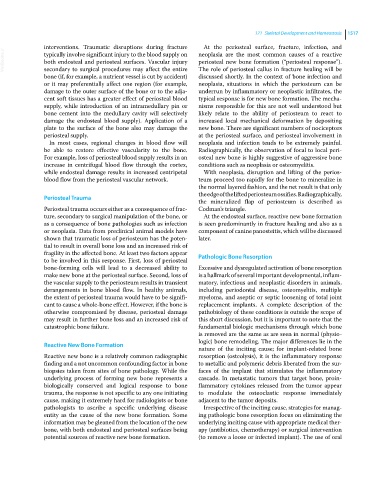Page 1579 - Clinical Small Animal Internal Medicine
P. 1579
171 Skeletal Development and Homeostasis 1517
interventions. Traumatic disruptions during fracture At the periosteal surface, fracture, infection, and
VetBooks.ir typically involve significant injury to the blood supply on neoplasia are the most common causes of a reactive
periosteal new bone formation (“periosteal response”).
both endosteal and periosteal surfaces. Vascular injury
secondary to surgical procedures may affect the entire
discussed shortly. In the context of bone infection and
bone (if, for example, a nutrient vessel is cut by accident) The role of periosteal callus in fracture healing will be
or it may preferentially affect one region (for example, neoplasia, situations in which the periosteum can be
damage to the outer surface of the bone or to the adja- underrun by inflammatory or neoplastic infiltrates, the
cent soft tissues has a greater effect of periosteal blood typical response is for new bone formation. The mecha-
supply, while introduction of an intramedullary pin or nisms responsible for this are not well understood but
bone cement into the medullary cavity will selectively likely relate to the ability of periosteum to react to
damage the endosteal blood supply). Application of a increased local mechanical deformation by depositing
plate to the surface of the bone also may damage the new bone. There are significant numbers of nociceptors
periosteal supply. at the periosteal surface, and periosteal involvement in
In most cases, regional changes in blood flow will neoplasia and infection tends to be extremely painful.
be able to restore effective vascularity to the bone. Radiographically, the observation of focal to local peri-
For example, loss of periosteal blood supply results in an osteal new bone is highly suggestive of aggressive bone
increase in centrifugal blood flow through the cortex, conditions such as neoplasia or osteomyelitis.
while endosteal damage results in increased centripetal With neoplasia, disruption and lifting of the perios-
blood flow from the periosteal vascular network. teum proceed too rapidly for the bone to mineralize in
the normal layered fashion, and the net result is that only
the edge of the lifted periosteum ossifies. Radiographically,
Periosteal Trauma
the mineralized flap of periosteum is described as
Periosteal trauma occurs either as a consequence of frac- Codman’s triangle.
ture, secondary to surgical manipulation of the bone, or At the endosteal surface, reactive new bone formation
as a consequence of bone pathologies such as infection is seen predominantly in fracture healing and also as a
or neoplasia. Data from preclinical animal models have component of canine panosteitis, which will be discussed
shown that traumatic loss of periosteum has the poten- later.
tial to result in overall bone loss and an increased risk of
fragility in the affected bone. At least two factors appear Pathologic Bone Resorption
to be involved in this response. First, loss of periosteal
bone‐forming cells will lead to a decreased ability to Excessive and dysregulated activation of bone resorption
make new bone at the periosteal surface. Second, loss of is a hallmark of several important developmental, inflam-
the vascular supply to the periosteum results in transient matory, infectious and neoplastic disorders in animals,
derangements in bone blood flow. In healthy animals, including periodontal disease, osteomyelitis, multiple
the extent of periosteal trauma would have to be signifi- myeloma, and aseptic or septic loosening of total joint
cant to cause a whole‐bone effect. However, if the bone is replacement implants. A complete description of the
otherwise compromised by disease, periosteal damage pathobiology of these conditions is outside the scope of
may result in further bone loss and an increased risk of this short discussion, but it is important to note that the
catastrophic bone failure. fundamental biologic mechanisms through which bone
is removed are the same as are seen in normal (physio-
logic) bone remodeling. The major differences lie in the
Reactive New Bone Formation
nature of the inciting cause; for implant‐related bone
Reactive new bone is a relatively common radiographic resorption (osteolysis), it is the inflammatory response
finding and a not uncommon confounding factor in bone to metallic and polymeric debris liberated from the sur-
biopsies taken from sites of bone pathology. While the faces of the implant that stimulates the inflammatory
underlying process of forming new bone represents a cascade. In metastatic tumors that target bone, proin-
biologically conserved and logical response to bone flammatory cytokines released from the tumor appear
trauma, the response is not specific to any one initiating to modulate the osteoclastic response immediately
cause, making it extremely hard for radiologists or bone adjacent to the tumor deposits.
pathologists to ascribe a specific underlying disease Irrespective of the inciting cause, strategies for manag-
entity as the cause of the new bone formation. Some ing pathologic bone resorption focus on eliminating the
information may be gleaned from the location of the new underlying inciting cause with appropriate medical ther-
bone, with both endosteal and periosteal surfaces being apy (antibiotics, chemotherapy) or surgical intervention
potential sources of reactive new bone formation. (to remove a loose or infected implant). The use of oral

